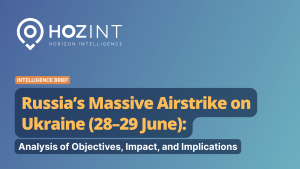
Airstrikes, drone strikes and ballistic missile strike in Ukraine in the past 90 days.
Key Points:
- On April 24, a major missile and drone attack by Russia on Kyiv killed at least nine and injured over 40, including children.
- The strike occurred in a heavily defended airspace, raising questions about the evolving capability of Russian long-range precision weapons.
- Attacks included cruise and ballistic missiles as well as UAVs (drones), indicative of complex, multi-domain strike tactics.
- This marks one of the deadliest attacks on Kyiv since the 2022 invasion and coincides with deteriorating diplomatic peace efforts.
- Civilian infrastructure, including residential buildings, was targeted, with widespread psychological and physical impacts.
- Increased risks to air navigation safety and aviation operations in Ukrainian FIRs, especially given proximity to conflict zones.
Threat Landscape and Analysis
The April 24, 2025, missile strike against Kyiv illustrates a significant escalation in Russia’s aerial campaign. Despite Kyiv being among the best-defended cities in Ukraine, with layered air defence systems including Western-supplied Patriot and NASAMS, the missile barrage breached these systems, inflicting mass casualties and extensive infrastructural damage. This underscores a persistent vulnerability in urban air defence when confronted with saturation attacks using mixed weapon types.
For aviation security, such an event underlines the elevated threat level to air operations in and around conflict zones. Notably, the attack utilised a blend of cruise missiles, ballistic missiles, and unmanned aerial vehicles (UAVs). This tactic complicates interception and situational awareness for both military and civil aviation stakeholders.
The missiles struck at approximately 01:00 AM local time, coinciding with low-visibility hours—often when detection and interception are more difficult. From an AVSEC standpoint, the timing also exacerbates psychological stress and emergency response difficulties, further stressing urban and aviation-related crisis response systems.
Implications for Civil Aviation
Kyiv’s proximity to international flight paths—despite the closure of Ukrainian airspace to civilian traffic—requires continuous monitoring due to the potential spillover risk. The unpredictability of missile trajectories and UAV operations elevates the risk of mid-air incidents, particularly for any overflying military or unauthorised civilian flights near Ukrainian FIRs (Flight Information Regions).
Further, such attacks reinforce the precedent set by the MH17 disaster in 2014, whereby civil aviation intersected with military conflict dynamics, with catastrophic consequences. Continued Russian deployment of long-range precision weapons capable of reaching western Ukraine, including Kyiv, expands the threat envelope and poses indirect risks to neighbouring states’ FIRs.
Strategic and Political Context
The strike comes at a diplomatically sensitive time, amid faltering US-led peace efforts and mounting international tensions. The overt targeting of civilians and critical infrastructure aligns with Russia’s strategic coercion model, aiming to demoralise the population and pressure political concessions. This may be interpreted as a deliberate defiance of ceasefire overtures and an indicator of continued conflict escalation.
President Zelensky’s refusal to concede Crimea and other territories underlines Ukraine’s resistance posture, but also ensures that the conflict’s trajectory remains uncertain, thus prolonging elevated threat levels to aviation and critical infrastructure.
The recent attacks, especially those on residential zones and near playgrounds, mark an increasing brazenness in target selection. For AVSEC, this signifies a trend towards less discriminate targeting, which may also include airfields, ATC facilities, or dual-use infrastructures relevant to aviation.
Recommendations for AVSEC Stakeholders
- Dynamic Risk Assessment Updates: Continually revise threat assessments for FIRs adjacent to Ukraine, especially those bordering Poland, Romania, and the Black Sea.
- Enhanced NOTAM Coordination: Civil aviation authorities should ensure real-time coordination on NOTAMs (Notices to Airmen) regarding military activity or missile alerts.
- Satellite and Radar Surveillance Integration: Enhance use of satellite imagery and radar for early warning of potential launch activity and UAV ingress.
- Cybersecurity Vigilance: Given the increasing complexity of hybrid warfare, ensure that ATC and airline networks are hardened against cyber intrusion, particularly in high-risk areas.
- Training and Scenario Planning: Bolster training for airport and airline staff on emergency response procedures, including shelter-in-place and evacuation drills tailored to missile threats.
- Collaborative Intelligence Sharing: Encourage multi-agency collaboration across intelligence, defence, and civil aviation sectors for unified situational awareness.
Conclusion
The April 2025 missile attack on Kyiv demonstrates the sustained high-intensity nature of the Russia-Ukraine conflict, with significant implications for regional airspace safety and broader aviation security planning. The use of complex missile and drone strategies in urban centres—even under robust air defence—reiterates the volatility of the air threat environment. AVSEC stakeholders must continue to adapt through intelligence integration, real-time coordination, and proactive resilience measures.




